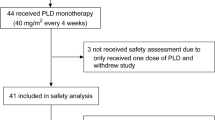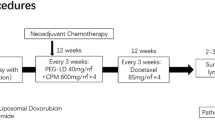Abstract
Purpose: To investigate the activity and tolerance of pegylated liposomal doxorubicin in combination with vinorelbine in pretreated patients with metastatic breast cancer. Patients and treatment: Thirty-six women with metastatic breast cancer were enrolled. The median age was 64 years, 80% of the patients had a performance status of 0–1, 30 (83%) had visceral disease and 83% had received prior taxanes while 50% anthracyclines. Treatment consisted of pegylated liposomal doxorubicin (40 mg/m2 on day 1) and vinorelbine (25 mg/m2 on days 1 and 15) every 4 weeks. Results: In an intention-to-treat analysis 2 (6%) complete and 12 (33%) partial responses were observed (overall response rate 39%; 95% CI: 23–54.8%); 8 (22%) and 14 (39%) patients experienced stable and progressive disease, respectively. The median TTP was 6.5 months and the median survival time 14.2 months. The 1-year survival rate was 54.1%. Grade 3 and 4 neutropenia occurred in 21 (58%) patients, grade 3–4 anemia in four (11%) and grade 4 thrombocytopenia in one (3%). Two (6%) patients developed febrile neutropenia. Non-hematologic toxicity was mild and easily manageable. There was no clinically important cardiac toxicity or treatment-related deaths. Conclusions: The combination of pegylated liposomal doxorubicin and vinorelbine is an active and well tolerated salvage regimen in patients with metastatic breast cancer which merits further evaluation.

Similar content being viewed by others
References
Perez DJ, Harvey VJ, Robinson BA et al (1991) Randomized comparison of single agent doxorubicin and epirubicin as first-line cytotoxic chemotherapy in advanced breast cancer. J Clin Oncol 9:2148–2152
von Hoff DD, Layard MW, Basa P et al (1979) Risk factors for doxorubicin-induced congestive heart failure. Ann Int Med 91:710–717
Bonadonna G, Gianni L, Santoro A et al (1993) Drugs ten years later: Epirubicin. Ann Oncol 4:359–369
Speyer J, Wasserheit C (1998) Strategies for reduction of anthracycline cardiac toxicity. Sem Oncol 25:525–537
Gabizon A, Martin F (1997) Polyethylene glycol-coated (pegylated) liposomal doxorubicin. Rational for use in solid tumors. Drugs 54:15–21
Symon Z, Peyser A, Tzemach D (1999) Selective delivery of doxorubicin to patients with breast carcinoma metastases by stealth liposomes. Cancer 86:72–78
Alberts DS, Garcia DJ (1997) Safety aspects of pegylated liposomal doxorubicin in patients with cancer. Drugs 54:30–35
Lyass O, Uziely B, Ben-Yozef R (2000) Correlation of toxicity with pharmacokinetics of pegylated doxorubicin in metastatic breast carcinoma. Cancer 89:1037–1047
Safra T, Muggia F, Jeffers S et al (2000) Pegylated liposomal doxorubicin (doxil): reduced clinical cardiotoxicity in patients reaching or exceeding cumulative doses of 500 mg/m2. Ann Oncol 11:1029–1033
Ranson MR, Carmichael J, O’Byrne K et al (1997) Treatment of advanced breast cancer with sterically stabilized liposomal doxorubicin: results of a multicenter phase II trial. J Clin Oncol 15:3185–3191
Shapiro CL, Ervin T, Welles L et al (1999) Phase II trial of high-dose liposome-encapsulated doxorubicin with granulocyte colony-stimulating factor in metastatic breast cancer. J Clin Oncol 17:1435–1441
Batist G, Ramakrishnan G, Rao CS et al (2001) Reduced cardiotoxicity and preserved antitumor efficacy of liposomal-encapsulated doxorubicin and cyclophosphamide compared with conventional doxorubicin and cyclophosphamide in a randomized, multicenter trial of metastatic breast cancer. J Clin Oncol 19:1444–1454
Androulakis N, Kouroussis Ch, Mavroudis D et al (2002) Phase I study of weekly paclitaxel and liposomal doxorubicin in patients with advanced solid tumors. Eur J Cancer 38:1992–1997
Mavroudis D, Kouroussis Ch, Kakolyris S et al (2002) Phase I study of paclitaxel (Taxol) and pegylated liposomal doxorubicin (Caelyx) administered every 2 weeks in patients with advanced solid tumors. Oncology 62:216–222
Jones S, Winer E, Vogel C et al (1995) Randomized comparison of vinorelbine and melphalan in anthracycline-refractory advanced breast cancer. J Clin Oncol 13:2567–2574
Weber BL, Vogel C, Jones S et al (1995) Intravenous vinorelbine as first-line and second-line therapy in advanced breast cancer. J Clin Oncol 13:2722–2730
Zelek L, Barthier S, Riofrio M et al (2001) Weekly vinorelbine is an effective palliative regimen after failure with anthracyclines and taxanes in metastatic breast carcinoma. Cancer 92:2267–2272
Spielmann M, Dorval T, Turpin F et al (1994) Phase II trial of vinorelbine/doxorubicin as first-line therapy of advanced breast cancer. J Clin Oncol 12:1764–1770
Norris B, Pritchard KI, James K et al (2000) Phase III comparative study of vinorelbine combined with doxorubicin versus doxorubicin alone in disseminated metastatic/recurrent breast cancer: National Cancer Institute of Canada Clinical Trials Group Study MA8. J Clin Oncol 18:2385–2394
Burstein HJ, Ramirez MJ, Petros WP et al (1999) Phase I study of Doxil and vinorelbine in metastatic breast cancer. Ann Oncol 10:113–116
Martin M, Garcia-Donas J, Casado A et al (2004) Phase II study of pegylated liposomal doxorubicin plus vinorelbine in breast cancer with previous anthracycline exposure. Clin Breast Cancer 5:353–357
Ajani JA, Welch SR, Raber MN et al (1990) Compressive criteria for assessing therapy-inducing toxicity. Cancer Invest 8:147–159
Miller AB, Hoogstraten BB, Staquet M et al (1981) Reporting results of cancer treatment. Cancer 47:207–214
A’Hern RP (2001) Sample size tablets for exact phase II clinical trials. Stat Med 20:859–866
Kaplan EL, Meier P (1959) Nonparametric estimation from incomplete observations. J Am Stat Assoc 53:457–481
Cox DR (1970) The analysis of binary data. London, Methuen
Bontenbal M, Andersson M, Wildiers J et al (1998) Doxoxrubicin vs epirubicin, report of a second-line randomized phase II/III study in advanced breast cancer. EORTC Breast Cancer Cooperative Group. Br J Cancer 77:2257–2263
Rivera E, Valero V, Esteva FJ et al (2002) Lack of activity of stealth liposomal doxorubicin in the treatment of patients with anthracycline-resistant breast cancer. Cancer Chemother Pharmacol 49:299–302
Rimassa L, Carnaghi C, Garassino I et al (2003) Unexpected low efficacy of stealth liposomal doxorubicin (Caelyx) and vinorelbine in metastatic breast cancer. Breast Cancer Res Treat 77:185–188
Alexopoulos CG, Rigatos G, Efremidis AP et al (1999) A phase II study of the effectiveness of docetaxel (Taxotere) in women with advanced breast cancer previously treated with polychemotherapy. Hellenic Cooperative Interhospital Group in Oncology. Cancer Chemother Pharmacol 44:253–258
Ramos M, Gonzalez-Ageitos A, Amenedo M et al (2003) Weekly docetaxel as second-line therapy for patients with advanced breast cancer resistant to previous anthracycline treatment. J Chemother 15:192–197
Mavroudis D, Malamos N, Alexopoulos A et al (1999) Salvage chemotherapy in anthracycline-pretreated breast cancer patients with docetaxel and gemcitabine: a multicenter phase II trial of the Greek Breast Cancer Cooperative Group. Ann Oncol 10:211–215
Donadio M, Ardine M, Berruti A et al (2003) Gemcitabine and vinorelbine as second-line treatment in patients with metastatic breast cancer: A phase II study. Cancer Chemother Pharmacol 52:147–152
Morabito A, Filippelli G, Palmeri S et al (2003) The combination of gemcitabine and vinorelbine is an active regimen as second-line therapy in patients with metastatic breast cancer pretreated with taxanes and/or anthracyclines: a phase I-II study. Breast Cancer Res Treat 78:29–36
Spielmann M, Dorval T, Turpin F et al (1994) Phase II trial of vinorelbine/doxorubicin as first-line therapy of advanced breast cancer. J Clin Oncol 12:1764–1770
Baldini E, Tibaldi C, Chiavacci F et al (1998) Epirubicin/vinorelbine as first line therapy in metastatic breast cancer. Breast Cancer Res Treat 49:129–134
Nistico C, Garufi C, Barni S et al (1999) Phase II study of epirubicin and vinorelbine with granulocyte colony-stimulating factor: a high-activity, dose-dense weekly regimen for advanced breast cancer. Ann Oncol 10:937–942
Vici P, Colucci G, Gebbia V et al (2002) First-line treatment with epirubicin and vinorelbine in metastatic breast cancer. J Clin Oncol 20:2689–2694
Pawlicki M, Rolski J, Zaluski J et al (2002) A phase II study of intravenous navelbine and doxorubicin combination in previously untreated advanced breast carcinoma. Oncologist 7:205–209
Gebbia V, Mauceri G, Fallica G et al (2002) Pegylated liposomal doxorubicin with vinorelbine in metastatic breast carcinoma. A phase I-II clinical investigation. Oncology 63:23–30
Serin D, Verrill M, Jones A et al (2005) Vinorelbine alternating oral and intravenous plus epirubicin in first-line therapy of metastatic breast cancer: results of a multicentre phase II study. Br J Cancer 92:1989–1996
Author information
Authors and Affiliations
Consortia
Corresponding author
Rights and permissions
About this article
Cite this article
Ardavanis, A., Mavroudis, D., Kalbakis, K. et al. Pegylated liposomal doxorubicin in combination with vinorelbine as salvage treatment in pretreated patients with advanced breast cancer: a multicentre phase II study. Cancer Chemother Pharmacol 58, 742–748 (2006). https://doi.org/10.1007/s00280-006-0236-3
Received:
Accepted:
Published:
Issue Date:
DOI: https://doi.org/10.1007/s00280-006-0236-3




